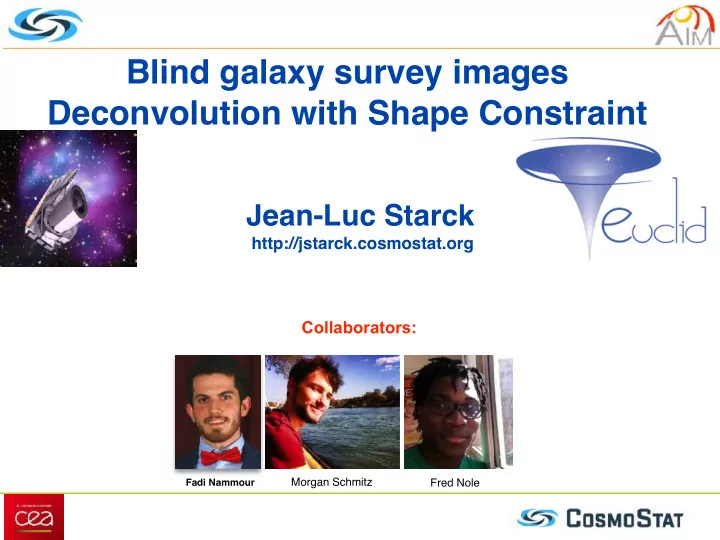

Blind galaxy survey images Deconvolution with Shape Constraint Jean-Luc Starck http://jstarck.cosmostat.org Collaborators: Morgan Schmitz Fred Nole Fadi Nammour
Weak Gravitational Lensing & Blind Deconvolution - Part I: Introduction to the Blind Deconvolution Problem - Part II: Point Spread Fonction (PSF) Field Recovery - Part III: Shape Measurements & Deconvolution
Weak Lensing Background galaxies Observer Gravitational lens CEA - Irfu
Euclid ESA Space Mission Euclid Mission • Medium-class mission in ESA’s Cosmic Vision program • 6 year survey, launch in Q4 2022 � probe the properties and nature of dark energy, dark matter, gravity and distinguish their effects decisively 2022 Optimized for weak lensing (and galaxy clustering) — 15,000 deg2 survey area — over 1.5 billion galaxies — redshifts out to z = 2 Gains in space: Stable data: homogeneous data set over the whole sky � Systematics are small, understood and controlled � Homogeneity : Selection function perfectly controlled
Galaxies
Detection + Classification stars/galaxies Galaxies Stars
Motivation for spatial observations
Convolution Operator + Sampling
Space Variant PSF
Euclid PSF Wavelength Dependency • PSF Modeling ➡ Undersampling ➡ Space dependency ➡ Wavelength dependency ➡ Time dependency
Shape Measurements Galaxies are convolved by an asymetric PSF + Images are undersampled Shape measurements must be deconvolved Methods: Moments (KSB), Shapelets, Forward-Fitting, Bayesian estimation, etc
State of the art: PSFextractor [E. Bertin, 2011] where h is Lanczos interpolation kernel Regularization
State of the art: PSF Modeling 1. Forward Modelling approach (FM) leaded by Lance Miller • Model the exit pupil using pre-defined Zemax modes. • Fit to all stars. ➡ PRO: No other existing method can achieve the very strong requirement on the PSF. ➡ CON: But hard to validate since i) the simulations are done with the same model, and ii) the model may change (vibrations at launch). 2. Need a data driven approach • Validate the FM solution on real data. • All surveys ((KIDS, CFHTLenS, DES) have used the data driven approach. • HST: TinyTim HST modelling software (Krist 1995) for the Hubble Space Telescope not as good as a data driven approach (Jee et al, PASP, 2007; Hoffmann and Anderson, Instrument Science Report ACS 2017-8, 2017). • What does not exist can be invented. • Combination of both approaches could lead to the optimal solution.
Blind Deconvolution –Introduction to the Blind Deconvolution Problem –Euclid PSF Field Measurement Monochromatic PSF: Matrix Factorization + Laplacian Graph + Sparsity • F. M. Mboula, J.-L. Starck, S. Ronayette, K. Okumura, and J. Amiaux, Super-resolution method using sparse regularization for point-spread function recovery. A&A, 575, id.A86, 2015. • F. Ngole, J.-L Starck, et al, “Constraint matrix factorization for space variant PSFs field restoration”, Inverse Problems, 2016. • M.A. Schmitz, J.-L. Starck and F.M. Ngolè, "Euclid Point Spread Function field recovery through interpolation on a Graph Laplacian", submitted, 2018. Polychromatic PSF and Optimal Transport • F.M. Ngolè Mboula, and J.-L. Starck, "PSFs field learning based on Optimal Transport distances", SIAM Journal on Imaging Sciences, 10, 3, pp. 979-1004, 2017. DOI: 10.1137/16M1093677. • M. A. Schmitz et a; "Wasserstein Dictionary Learning:Optimal Transport-based unsupervised representation learning", SIAM Journal on Imaging Sciences, 11, 2018. –Shape Measurements & Deconvolution
The PSF Field Recovery Problem Observed PSF “True” PSF (punctual star convolved with true PSF) Flat to 1-D vector Datapoint matrix X matrix Pixels Pixels Random shifting N N/4 Decimation Datapoint Noise Degradation . . . . . . . . . . . . . . . . . . matrix M 0 0 Datapoints . . . Datapoints . . . 0 K 0 K : true PSFs at different positions of the FOV. X ∈ R N × K + � Y � MX � 2 min : decimation and shifting. X : observed PSFs.
The PSF Super-resolution Challenge
Inverse Problems & Regularization Y = HX + N X || Y − HX || 2 C ( X ) min + Physical Knowledge on X (ex: Gaussian Random Field, etc). ==> Gaussian smoothing, Wiener reconstruction, etc ==> Log normal distribution prior X properties are understood through a representative data set. ==> Machine Learning Knowledge on the histogram of X in pixel space or in another one. ==> Positivity constraint, sparsity constraint, etc.
<latexit sha1_base64="BGy0wU3NROsLcxBQ3kBsivhF+Lc=">ACEHicbVBNS8NAEJ3Ur1q/oh69LBbRU0lE0GPRi8cKthWaEDbt0dxN2N0IJ/Qle/CtePCji1aM3/43bNqC2Ph4vDfDzLw45Uwbz/tySkvLK6tr5fXKxubW9o67u9fSaYIbZKEJ+ouxpyJmnTMPpXaoFjGn7Xh4NfHb91RplshbM0pKHBfsh4j2Fgpco8DnYlIoSDFCnNOQoaA4Z0xH6kyEcocqtezZsCLRK/IFUo0Ijcz6CbkExQaQjHWnd8LzVhjpVhNxJcg0TEZ4j7tWCqxoDrMpw+N0ZFVuqiXKFvSoKn6eyLHQuRiG2nwGag572J+J/XyUzvIsyZTDNDJZkt6mUcmQRN0kFdpigxfGQJorZWxEZ2BiIsRlWbAj+/MuLpHVa872af3NWrV8WcZThA7hBHw4hzpcQwOaQOABnuAFXp1H59l5c95nrSWnmNmHP3A+vgFBk5wN</latexit> <latexit sha1_base64="BGy0wU3NROsLcxBQ3kBsivhF+Lc=">ACEHicbVBNS8NAEJ3Ur1q/oh69LBbRU0lE0GPRi8cKthWaEDbt0dxN2N0IJ/Qle/CtePCji1aM3/43bNqC2Ph4vDfDzLw45Uwbz/tySkvLK6tr5fXKxubW9o67u9fSaYIbZKEJ+ouxpyJmnTMPpXaoFjGn7Xh4NfHb91RplshbM0pKHBfsh4j2Fgpco8DnYlIoSDFCnNOQoaA4Z0xH6kyEcocqtezZsCLRK/IFUo0Ijcz6CbkExQaQjHWnd8LzVhjpVhNxJcg0TEZ4j7tWCqxoDrMpw+N0ZFVuqiXKFvSoKn6eyLHQuRiG2nwGag572J+J/XyUzvIsyZTDNDJZkt6mUcmQRN0kFdpigxfGQJorZWxEZ2BiIsRlWbAj+/MuLpHVa872af3NWrV8WcZThA7hBHw4hzpcQwOaQOABnuAFXp1H59l5c95nrSWnmNmHP3A+vgFBk5wN</latexit> <latexit sha1_base64="BGy0wU3NROsLcxBQ3kBsivhF+Lc=">ACEHicbVBNS8NAEJ3Ur1q/oh69LBbRU0lE0GPRi8cKthWaEDbt0dxN2N0IJ/Qle/CtePCji1aM3/43bNqC2Ph4vDfDzLw45Uwbz/tySkvLK6tr5fXKxubW9o67u9fSaYIbZKEJ+ouxpyJmnTMPpXaoFjGn7Xh4NfHb91RplshbM0pKHBfsh4j2Fgpco8DnYlIoSDFCnNOQoaA4Z0xH6kyEcocqtezZsCLRK/IFUo0Ijcz6CbkExQaQjHWnd8LzVhjpVhNxJcg0TEZ4j7tWCqxoDrMpw+N0ZFVuqiXKFvSoKn6eyLHQuRiG2nwGag572J+J/XyUzvIsyZTDNDJZkt6mUcmQRN0kFdpigxfGQJorZWxEZ2BiIsRlWbAj+/MuLpHVa872af3NWrV8WcZThA7hBHw4hzpcQwOaQOABnuAFXp1H59l5c95nrSWnmNmHP3A+vgFBk5wN</latexit> <latexit sha1_base64="BGy0wU3NROsLcxBQ3kBsivhF+Lc=">ACEHicbVBNS8NAEJ3Ur1q/oh69LBbRU0lE0GPRi8cKthWaEDbt0dxN2N0IJ/Qle/CtePCji1aM3/43bNqC2Ph4vDfDzLw45Uwbz/tySkvLK6tr5fXKxubW9o67u9fSaYIbZKEJ+ouxpyJmnTMPpXaoFjGn7Xh4NfHb91RplshbM0pKHBfsh4j2Fgpco8DnYlIoSDFCnNOQoaA4Z0xH6kyEcocqtezZsCLRK/IFUo0Ijcz6CbkExQaQjHWnd8LzVhjpVhNxJcg0TEZ4j7tWCqxoDrMpw+N0ZFVuqiXKFvSoKn6eyLHQuRiG2nwGag572J+J/XyUzvIsyZTDNDJZkt6mUcmQRN0kFdpigxfGQJorZWxEZ2BiIsRlWbAj+/MuLpHVa872af3NWrV8WcZThA7hBHw4hzpcQwOaQOABnuAFXp1H59l5c95nrSWnmNmHP3A+vgFBk5wN</latexit> Constraints Joint estimations of super-resolved PSFs at stars positions ➡ Low rank constraint: Constraint the PSFs to be a Eigen PSF linear combination of the eigenvectors PSFs: r s i = ith vector (2D image) PSF ( k ) = x k = X a i,k s i a i,k = coefficient corresponding to contribution of the i-th vector to the k-th PSF. i =1 Positivity constraint ( x k > 0 ) ➡ X k Φ s i k 1 ➡ Smoothness constraint on each s i r ➡ Proximity constraint on the a i,k coefficients: the closer are the stars, the more the coefficients of the linear combination are similar. u i ∈ U stars f ( � u k 1 � u k 2 � 2 ) a 1 ,i a k,i a 2 ,i a .,i a .,i a K,i
PSF Laplacian Graph Laplacian Graph P = D - J , where D is the degree matrix and J is the adjacent matrix of the graph P t P = V Λ V t Degree matrix= diagonal matrix with information about the degree of each vertex—that is, the number of edges attached to each vertex. Adjacent matrix A: element Aij is one when there is an edge from vertex i to vertex j, and zero when there is no edge.
Recommend
More recommend